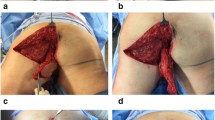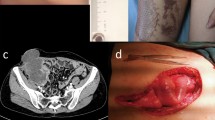Abstract
Purpose
Total intersphincteric resection (total ISR) is a surgical option for patients with advanced cancer of the lower rectum. However, anorectal stricture can develop after total ISR, which stretches from the anus to the lower rectum. Conventional anoplasty for anal stricture is often ineffective for them because the areas of stricture are long and the most proximal points of the strictures are too far for advancement flaps or rotation flaps to reach. We have developed a new surgical treatment method using a gluteal-fold flap (GFF) for anal stricture after total ISR.
Methods
From April 2004 through June 2007, hemilateral GFFs were transferred to treat anorectal strictures after total ISR in three patients at the National Cancer Center Hospital East, Chiba, Japan. Postoperative results and anal function were evaluated.
Results
In all three patients, GFFs were successfully transferred, and good dilation of the anorectal stenosis was achieved. Postoperative anal function was satisfactory.
Conclusion
The GFF has a rich vascular supply and can be simply and reliably transferred. We believe that GFF transfer is an excellent option for treating anorectal strictures after total ISR.








Similar content being viewed by others
References
Schiessel R, Novi G, Holzer B, Rosen HR, Renner K, Holbling N, Feil W, Urban M (2005) Technique and long-term results of intersphincteric resection for low rectal cancer. Dis Colon Rectum 48(10):1858–1865. doi:10.1007/s10350-005-0134-5, discussion 1865-7
Saito N, Sugito M, Ito M, Kobayashi A, Nishizawa Y, Yoneyama Y, Minagawa N (2009) Oncologic outcome of intersphincteric resection for very low rectal cancer. World J Surg 33(8):1750–1756. doi:10.1007/s00268-009-0079-2
Schiessel R, Rosen HR (2000) Preservation and restoration of sphincter function in patients with rectal cancer. Can J Gastroenterol 14(5):423–426
Brisinda G, Vanella S, Cadeddu F, Marniga G, Mazzeo P, Brandara F, Maria G (2009) Surgical treatment of anal stenosis. World J Gastroenterol 15(16):1921–1928
Casadesus D, Villasana LE, Diaz H, Chavez M, Sanchez IM, Martinez PP, Diaz A (2007) Treatment of anal stenosis: a 5-year review. ANZ J Surg 77(7):557–559. doi:10.1111/j.1445-2197.2007.04151.x
Liberman H, Thorson AG (2000) How I do it. Anal stenosis. Am J Surg 179(4):325–329. doi:S0002961000003445
Yii NW, Niranjan NS (1996) Lotus petal flaps in vulvo-vaginal reconstruction. Br J Plast Surg 49(8):547–554
Ragoowansi R, Yii N, Niranjan N (2004) Immediate vulvar and vaginal reconstruction using the gluteal-fold flap: long-term results. Br J Plast Surg 57(5):406–410. doi:10.1016/j.bjps.2004.02.022
Knol AC, Hage JJ (1997) The infragluteal skin flap: a new option for reconstruction in the perineogenital area. Plast Reconstr Surg 99(7):1954–1959
Kosugi C, Saito N, Kimata Y, Ono M, Sugito M, Ito M, Sato K, Koda K, Miyazaki M (2005) Rectovaginal fistulas after rectal cancer surgery: incidence and operative repair by gluteal-fold flap repair. Surgery 137(3):329–336. doi:10.1016/j.surg.2004.10.004
Hashimoto I, Nakanishi H, Nagae H, Harada H, Sedo H (2001) The gluteal-fold flap for vulvar and buttock reconstruction: anatomic study and adjustment of flap volume. Plast Reconstr Surg 108(7):1998–2005
Acknowledgment
This work is supported by the National Cancer Center Hospital East.
Conflict of interest
The authors declare that they have no proprietary, financial, professional or other personal interest of any nature or kind in any product, service and/or company that could be construed as influencing the position presented in this manuscript.
Author information
Authors and Affiliations
Corresponding author
Rights and permissions
About this article
Cite this article
Tsuchiya, S., Sakuraba, M., Asano, T. et al. New application of the gluteal-fold flap for the treatment of anorectal stricture. Int J Colorectal Dis 26, 653–659 (2011). https://doi.org/10.1007/s00384-010-1115-2
Accepted:
Published:
Issue Date:
DOI: https://doi.org/10.1007/s00384-010-1115-2




